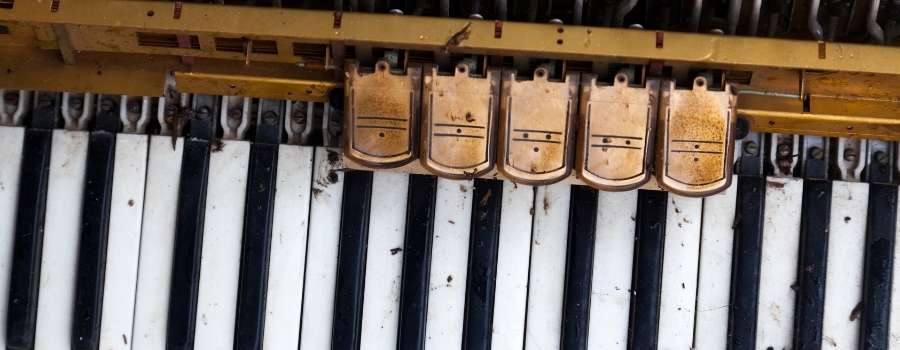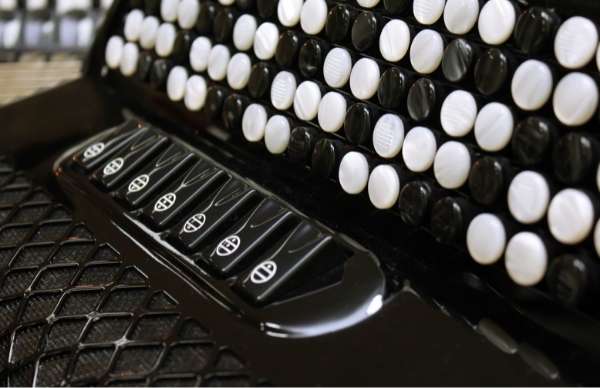
It seems like most things we purchase will almost immediately be worth significantly less right when you get it home. Luckily, musical instruments aren’t as finicky and many, well-made instruments have a good chance of holding some if not all of their value…some even gain value over the years.
That got me thinking about accordions…they are a more niche instrument, but most seem to be well made and fairly intricate. I thought I’d do a little digging and put this article together to cover details on determining an accordion’s age, how much it’s worth, and some tips on how to sell it.
Three factors are important to keep in mind when judging an accordion’s monetary value, including vintage accordions:
- Condition
- Brand
- Size/type
Are Old Accordions Worth Any Money?
In general, if an accordion is in great condition and is from a reputable manufacturer then it should hold some monetary value. How much will depend on factors such as age, condition, and builder. Instruments used by famous musicians or on important albums can also be worth a good amount of money.
The accordion is a relatively new instrument, compared to many other classic instruments such as violins or pianos, and the first accordion was made in 1829, according to WiseGeek.com. So even the oldest versions don’t fetch the same enormous price tags as the 1655 Cristofori piano.
Speaking of accordion value, I put together this article on some common prices for the three main types of accordion: Piano Style, Button, and Concertina.
However, depending on the accordion’s condition, brand, size, and possibilities, your old accordion could be worth some decent cash.
Condition
Playability is considered the most important factor in determining an accordion’s monetary value.
Unless the accordion is a genuine antique dating from the 1800s and has some antique value behind it, your vintage accordion must be playable. If it isn’t playable, then you – as the seller – are responsible for deducting the cost of repairs from its value.
Accordion repairs and tuning can be expensive, and buyers generally prefer one in playable condition to one they’ll have to spend money to repair.
This is particularly true of older accordions. If not played regularly, old accordions are susceptible to deteriorating, even in ideal storage environments. Leather, felt, wax, and glue can degrade quickly, which will negatively affect the sound and overall condition of the instrument.
Sometimes the deterioration of the moving parts isn’t evident when testing out a used accordion. To accurately determine the condition, you should take the instrument to a repair expert, who will open up the accordion to check for any damage.
Accordions require servicing every few years, even if they remain unplayed, to remain in optimal condition.
Brand
Accordions made from brands in Germany, Austria, and Italy are generally of higher quality than those from China or Eastern European countries and therefore have more monetary value.
There are perhaps hundreds of different brands that make accordions, but the following lists the most notable from each category:
Best known German, Austrian, and Italian brands:
- Hohner
- Scandalli
- Paolo Soprani
- Victoria
- Pigini
- Fratelli Crosio
Some well-known Chinese and Eastern European accordion brands are:
- Hero
- Parrot
- Delicia
Keep in mind that those listed are just a small percentage of the myriad of accordion brands out there. Because of the vast number of brands that make accordions, there are high-quality instruments from lesser-known brands. While it’s one of the factors in determining a used accordion’s value, it isn’t as important as condition or size, and type.
Brands that mass produce their instruments are going to be less valuable than those brands that don’t.
Size/Type
There are two main kinds of accordions:
- Button – as their name suggests, button accordions have buttons the player pushes to produce notes rather than keys. According to the manufacturer Hohner’s website, button accordions are the most common kind played in North and South America. They have one button per two notes, and the note depends on whether the player pulls or pushes the bellows. They are generally smaller than piano accordions.
- Piano – most commonly used throughout Russia and Europe, these accordions are known for the black and white piano keys lining the right-hand side.
Chromatic accordions have buttons for both the treble (right-hand side) and the bass (left-hand side).
Concertinas are small, hand-held accordions that are much smaller than the diatonic or piano varieties. While the concertina is too small to be considered a true accordion, it has enough similarities to make it an accordion variant. They are also in high demand given their portability.
The number of bass buttons an accordion has is how buyers and sellers judge the instrument’s size. A full-size accordion has 120 bass keys. An accordion is generally considered professional grade if it has at least 60 bass keys. Anything less is typically a lower-quality student model.
You’ll generally get more money for a full-size accordion, but this also depends on condition and brand. Some concertinas, despite their size, can fetch prices higher than full-size accordions. However, this varies greatly and also depends on condition and brand.

What Makes An Accordion Vintage?
In general, an accordion is considered vintage if it is between 40 and 100 years old. Older models fall into the antique category. Vintage accordions will usually have some sort of name recognition or cultural significance that increases their value and collectability.
While an antique items’ age is what makes them valuable, this isn’t necessarily the case for vintage ones. How old an item has to be in order to be considered vintage vary, but most experts agree that the item must be at least 40 years old and less than 100. Accordions are no exception.
Pre-war accordions, meaning accordions made before World War II, are considered antiques and have little commercial value, but can have high collectible value depending on their condition.
How Can I Tell How Old My Accordion Is?
To determine your accordions age, you’ll want to locate the serial number and note the make and model and take photos detailing maufacturing and construction. Then you’ll want to ask the manufacturer for an assesment. Some instrument retailers, appraisers, and online sources can also help.
Most major accordion brands are still in business, so looking up the manufacturer’s contact information shouldn’t be a problem.
Usually, there will be a process in submitting the photographs of the accordion, including the serial number, and the manufacturer should be able to provide you with your accordion’s original manufacture date. There is sometimes involved for the company to look up your accordion’s age…Hohner, for example, provides this service for $35.
Without the serial number, determining the age can be much more difficult. During the Golden Age of accordion manufacturing, which was in the mid-1900s from Italy, most accordions were manufactured without serial numbers or brands names, allowing retailers to stamp the instruments with their own brand name before putting them up for sale.
Where Do I Find My Accordion’s Serial Number?
The serial number is generally located in the back corner of the instrument.
What if the Serial Number is Missing or Faded?
If the serial number is missing or illegible, your best choice for determining the value of your accordion is to take it to an appraiser. The appraiser will be able to tell the age, as well as the condition and value.
Where Can I Sell My Vintage Accordion?
As with any vintage or antique item, the value an appraiser attaches to your accordion may be higher than what you can successfully sell it for. You also have to find the right buyer.
- Local music store – this is a good option if your vintage accordion isn’t too old and you want to sell it quickly
- Craigslist – a great option if you don’t mind hanging onto the accordion for a while, since you may not find a buyer right away. A positive aspect is naming your own price, but that can either help or hinder you, depending on demand
- eBay – the best option for selling antique, pre-war accordions, since these instruments are of little interest commercially. Also a great option for selling accordions of any age, and several websites on accordions recommend eBay as the best way to get the maximum amount for your accordion



